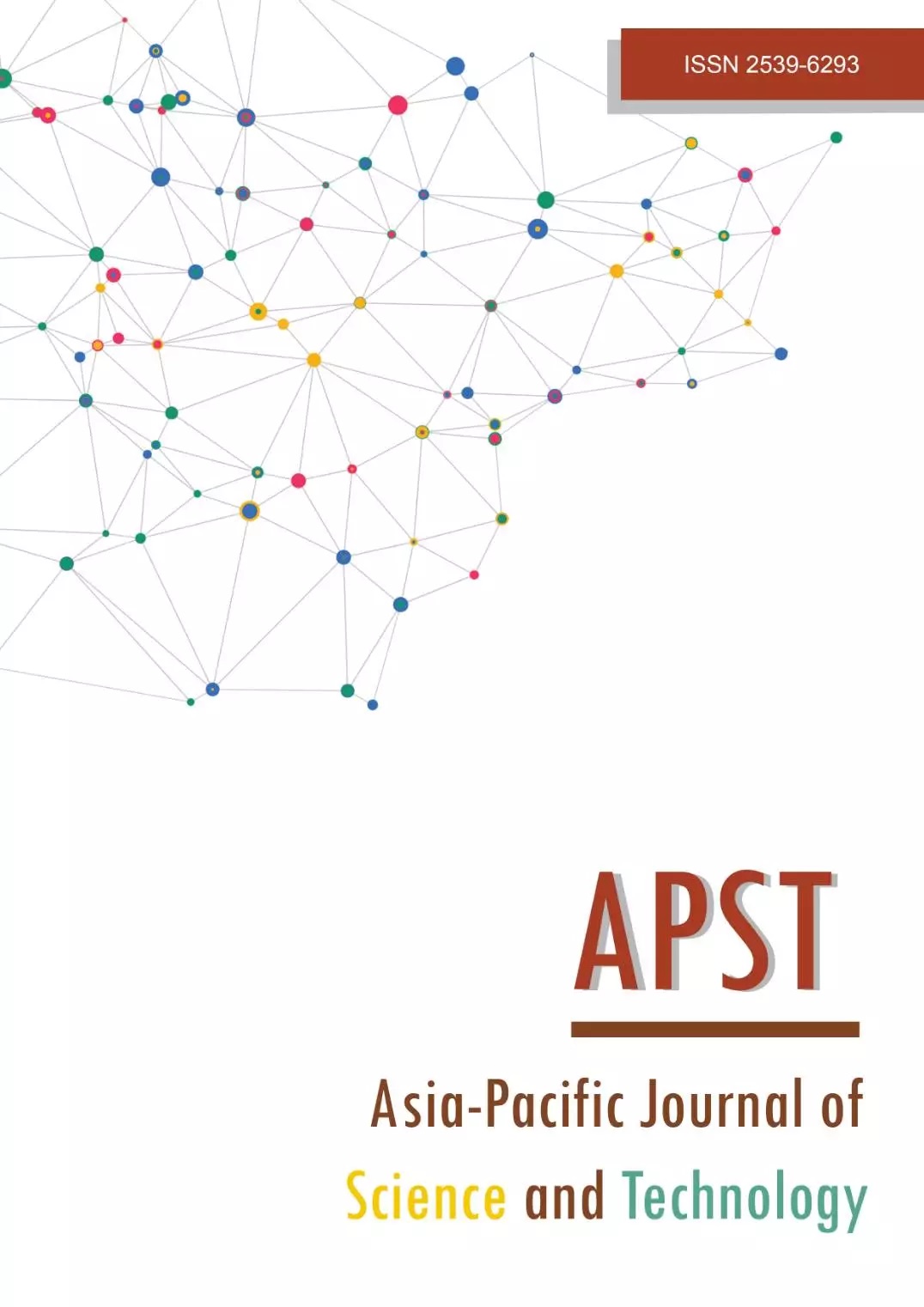N501Y mutation in SARS-CoV-2 spike RBD protein enhances its binding to ACE2 receptor
Main Article Content
Abstract
Studies have indicated that the N501Y mutation in the spike protein of SARS-CoV-2 enhances the binding efficiency between its receptor-binding domain (RBD) and the human angiotensin-converting enzyme 2 (ACE2) receptor, decreasing vaccine effectiveness and increasing the potential for viral infection. In this work, the structures of the wild-type RBD and N501Y-RBD in complex with the ACE2 receptor were generated to evaluate the effect of the N501Y mutation on their binding efficiency using molecular dynamics simulations, free energy calculations based on the MM/GB(PB)SA and SIE methods, and residue interaction network analysis. The results revealed that the N501Y-RBD/ACE2 complex displays higher compactness than the wild-type RBD/ACE2 structure via strong H-bonding, π–π, and van der Waals interactions. Moreover, the number of hot-spot residues in N501Y-RBD/ACE2 was higher than that of the wild-type RBD/ACE2 system. Structural and energetic insights gained from the study could be utilised for the design of novel drugs and vaccines against newly emerging coronavirus strains.
Article Details

This work is licensed under a Creative Commons Attribution-NonCommercial-NoDerivatives 4.0 International License.
References
Organization WH. World Health organization (WHO) [Internet]. 2020 [cited 2022 Sep 14]. Available from: https://www.who.int/emergencies/diseases/novel-coronavirus-2019.
Huang C, Wang Y, Li X, Ren L, Zhao J, Hu Y, et al. Clinical features of patients infected with 2019 novel coronavirus in Wuhan, China. The Lancet. 2020;395(10223):497-506.
Marra MA, Jones SJM, Astell CR, Holt RA, Brooks-Wilson A, Butterfield YSN, et al. The genome sequence of the SARS-associated coronavirus. Science. 2003;300(5624):1399-1404.
Rota PA, Oberste MS, Monroe SS, Nix WA, Campagnoli R, Icenogle JP, et al. Characterization of a novel coronavirus associated with severe acute respiratory syndrome. Science. 2003;300(5624):1394-1399.
Tortorici MA, Veesler D. Chapter Four - Structural insights into coronavirus entry. In: Rey FA, editor. Advances in Virus Research (Volume 105). Cambridge: Academic Press; 2019. p. 93-116.
Jackwood M, Hilt D, Callison S, Lee CW, Plaza H, Wade E. Spike glycoprotein cleavage recognition site analysis of infectious bronchitis virus. Avian diseases. 2001;45:366-372.
Xu H, Zhong L, Deng J, Peng J, Dan H, Zeng X, et al. High expression of ACE2 receptor of 2019-nCoV on the epithelial cells of oral mucosa. Int J Oral Sci. 2020;12(1):8.
Zhang H, Kang Z, Gong H, Xu D, Wang J, Li Z, et al. The digestive system is a potential route of 2019-nCov infection: a bioinformatics analysis based on single-cell transcriptomes. bioRxiv: the preprint server for biology. https://doi.org/10.1101/2020.01.30.927806.
Davies NG, Abbott S, Barnard RC, Jarvis CI, Kucharski AJ, Munday J, et al. Estimated transmissibility and severity of novel SARS-CoV-2 Variant of Concern 202012/01 in England. medRxiv: the preprint server for health sciences. doi: https://doi.org/10.1101/2020.12.24.20248822.
Greaney AJ, Loes AN, Crawford KHD, Starr TN, Malone KD, Chu HY, et al. Comprehensive mapping of mutations in the SARS-CoV-2 receptor-binding domain that affect recognition by polyclonal human plasma antibodies. Cell Host Microbe. 2021;29(3):463-476.
Xie X, Zou J, Fontes-Garfias CR, Xia H, Swanson KA, Cutler M, et al. Neutralization of N501Y mutant SARS-CoV-2 by BNT162b2 vaccine-elicited sera. bioRxiv: the preprint server for biology. doi: https://doi.org/10.1101/2021.01.07.425740.
Zhu X, Mannar D, Srivastava SS, Berezuk AM, Demers J-P, Saville JW, et al. Cryo-electron microscopy structures of the N501Y SARS-CoV-2 spike protein in complex with ACE2 and 2 potent neutralizing antibodies. PLOS Biology. 2021;19(4):e3001237.
Luan B, Wang H, Huynh T. Enhanced binding of the N501Y-mutated SARS-CoV-2 spike protein to the human ACE2 receptor: insights from molecular dynamics simulations. FEBS Letters. 2021;595(10):1454-1461.
Verkhivker G, Agajanian S, Kassab R, Krishnan K. Computer simulations and network-based profiling of binding and allosteric interactions of SARS-CoV-2 spike variant complexes and the host receptor: Dissecting the mechanistic effects of the delta and omicron mutations. Int J Mol Sci. 2022;23(8):4376.
Homeyer N, Gohlke H. Free energy calculations by the molecular mechanics poisson−boltzmann surface area method. Mol Inform. 2012;31(2):114-122.
Sulea T, Cui Q, Purisima EO. Solvated Interaction Energy (SIE) for scoring protein–ligand binding affinities. 2. benchmark in the CSAR-2010 scoring exercise. J Chem Inf Model. 2011;51(9):2066-2081.
Lan J, Ge J, Yu J, Shan S, Zhou H, Fan S, et al. Structure of the SARS-CoV-2 spike receptor-binding domain bound to the ACE2 receptor. Nature. 2020;581(7807):215-220.
Case D, Betz R, Cerutti DS, Cheatham T, Darden T, Duke R, et al. Amber 2016. San Francisco: University of California; 2016.
Olsson MH, Sondergaard CR, Rostkowski M, Jensen JH. PROPKA3: Consistent treatment of internal and surface residues in empirical pKa predictions. J Chem Theory Comput. 2011;7(2):525-537.
Maier JA, Martinez C, Kasavajhala K, Wickstrom L, Hauser KE, Simmerling C. ff14SB: Improving the accuracy of protein side chain and backbone parameters from ff99SB. J Chem Theory Comput. 2015;11(8):3696-3713.
Leontyev IV, Stuchebrukhov AA. Polarizable mean-field model of water for biological simulations with AMBER and CHARMM force fields. J Chem Theory Comput. 2012;8(9):3207-3216.
Mahalapbutr P, Lee VS, Rungrotmongkol T. Binding hotspot and activation mechanism of maltitol and lactitol toward the human sweet taste receptor. J Agric Food Chem. 2020;68(30):7974-7983.
Elber R, Ruymgaart AP, Hess B. SHAKE parallelization. Eur Phys J Spec Top. 2011;200(1):211-223.
Darden TA, York DM, Pedersen LG. Particle mesh Ewald: An N⋅log(N) method for Ewald sums in large systems. J Chem Phys. 1993;98(12):10089-10092.
Roe DR, Cheatham TE. PTRAJ and CPPTRAJ: Software for processing and analysis of molecular dynamics trajectory data. J Chem Theory Comput. 2013;9(7):3084-3095.
Clementel D, Del Conte A, Monzon AM, Camagni Giorgia F, Minervini G, Piovesan D, et al. RING 3.0: fast generation of probabilistic residue interaction networks from structural ensembles. Nucleic Acids Res. 2022;50(W1):W651-W656.
Shannon P, Markiel A, Ozier O, Baliga NS, Wang JT, Ramage D, et al. Cytoscape: A software environment for integrated models of biomolecular interaction networks. Genome Res. 2003;13(11):2498-2504.
Ramachandran GN, Ramakrishnan C, Sasisekharan V. Stereochemistry of polypeptide chain configurations. J Mol Biol. 1963;7(1):95-99.
Anderson RJ, Weng Z, Campbell RK, Jiang X. Main-chain conformational tendencies of amino acids. Proteins. 2005;60(4):679-689.
Jawad B, Adhikari P, Podgornik R, Ching WY. Key interacting residues between RBD of SARS-CoV-2 and ACE2 receptor: combination of molecular dynamics simulation and density functional calculation. J Chem Inf Model. 2021;61(9):4425-41.


